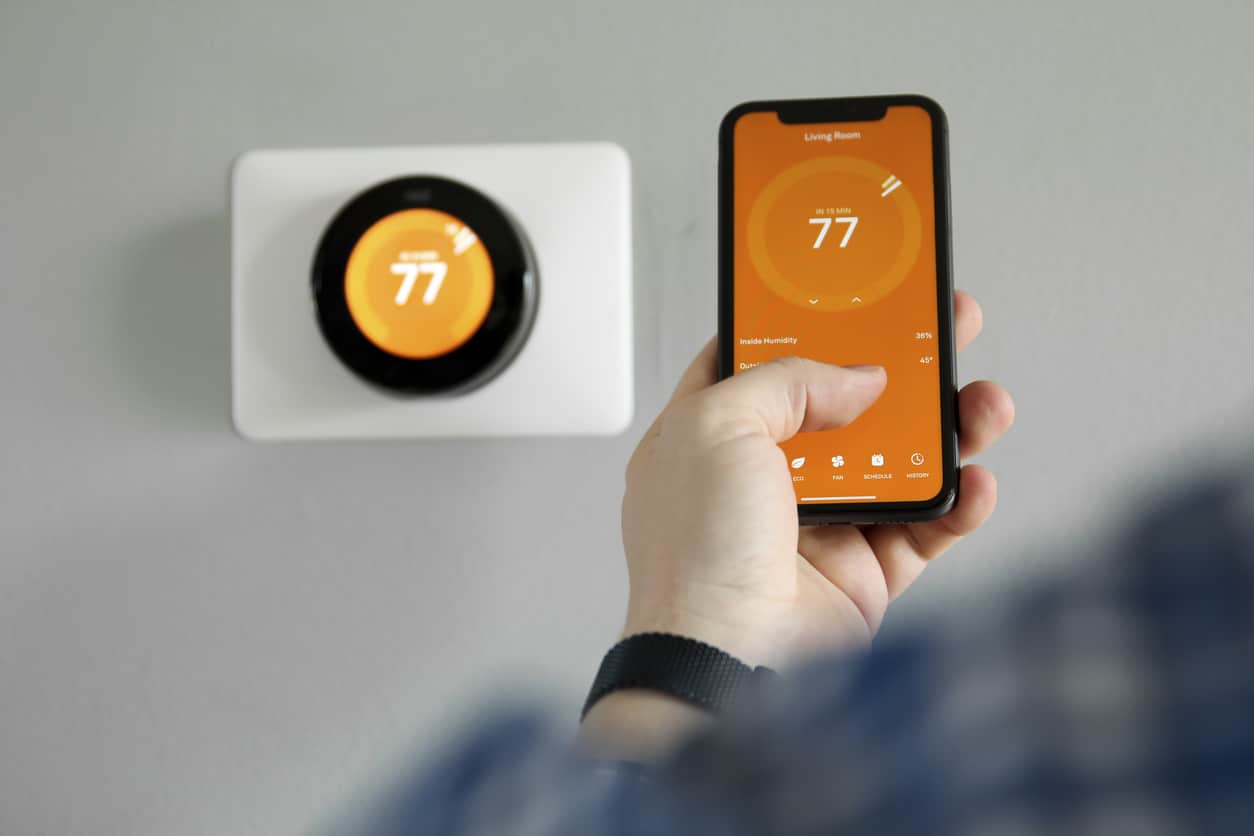- Enhanced Comfort: Automatically adjusts to coastal temperature and humidity changes.
- Energy Efficiency: Optimizes heating/cooling, reducing energy costs.
- Remote Control: Manage your home’s climate from anywhere via smartphone.
- Humidity Management: Built-in sensors maintain optimal indoor humidity levels.
- Integration: Works seamlessly with other smart devices like dehumidifiers and air purifiers.
Installation Tips:
- Choose professional installation for coastal homes to handle humidity and salt air.
- Protect with surge protectors to prevent damage from coastal storms.
Maintenance:
- Regular cleaning and software updates ensure longevity and performance.
Are you tired of constantly adjusting your home’s temperature?
Smart thermostats might be the solution you’re looking for. These advanced devices allow you to control your home’s heating and cooling systems remotely. But what exactly are they?
A smart thermostat is a Wi-Fi-enabled device that can automatically adjust temperature settings for optimal performance. Unlike traditional thermostats, these modern gadgets learn from your behaviors and can be controlled through your smartphone.
Imagine being able to lower the temperature while you’re at work and have it just right by the time you get home. Smart thermostats make this possible, saving you both time and energy.
Benefits of Smart Thermostats for Coastal Living
Living near the coast has its perks, but it also comes with unique challenges for home maintenance, including temperature and humidity control. Here’s why smart thermostats are especially beneficial for coastal homes:
- Enhanced Comfort: Coastal climates can be unpredictable, with sudden changes in temperature and humidity. A smart thermostat ensures your home remains comfortable by adapting to these fluctuations automatically.
- Energy Efficiency: Coastal homes often experience high energy costs due to extreme weather conditions. Smart thermostats help reduce these costs by optimizing your heating and cooling schedules based on your daily routines and weather patterns.
- Remote Control: When you live near the coast, you’re likely to spend a lot of time outdoors or traveling. Smart thermostats let you control your home’s temperature from anywhere, ensuring a comfortable environment upon your return.
- Humidity Management: Coastal areas are prone to high humidity levels, which can affect your home’s air quality. Some smart thermostats come with built-in humidity sensors, allowing you to maintain optimal indoor humidity levels.
- Integration with Other Smart Devices: Coastal living often means taking extra precautions against environmental factors like salt air and humidity. Smart thermostats can integrate with other smart home devices like dehumidifiers and air purifiers to create a cohesive, efficient home environment.
Key Features of Smart Thermostats
Energy Efficiency
Have you ever wondered how to keep your energy bills low without sacrificing comfort? Smart thermostats are designed to optimize your home’s heating and cooling, which can lead to significant energy savings. They use advanced algorithms to learn your schedule and preferences, adjusting the temperature automatically when you’re away or asleep. By minimizing energy use during these times, smart thermostats can help reduce your overall consumption, making your home more energy-efficient and environmentally friendly.
Remote Control via Apps
Imagine controlling your home’s temperature from your smartphone, no matter where you are. With smart thermostats, this convenience is at your fingertips. These devices connect to your home’s Wi-Fi network, allowing you to manage your HVAC system through an app. Whether you’re on vacation, at work, or just lounging on the couch, you can adjust the temperature with a few taps on your phone. This feature is particularly useful for coastal residents who spend a lot of time outdoors or traveling, ensuring their home is always at the perfect temperature when they return.
Learning Capabilities
One of the standout features of smart thermostats is their ability to learn from your habits and preferences. Over time, these devices gather data on your daily routines and adjust the temperature accordingly. For example, if you usually leave for work at 8 AM and return at 6 PM, the thermostat will automatically lower the temperature during the day and raise it just before you get home. This adaptive learning helps maintain comfort while maximizing energy efficiency, making smart thermostats a smart choice for any home.
Compatibility with Other Smart Devices
Do you have a smart home ecosystem with devices like Amazon Alexa, Google Assistant, or Apple HomeKit? Smart thermostats seamlessly integrate with these platforms, allowing you to control your thermostat using voice commands or through your existing smart home app. This compatibility extends to other smart home devices such as humidifiers, air purifiers, and even smart vents, creating a fully interconnected home environment. For coastal homes, this integration means you can manage multiple aspects of your indoor climate with ease, ensuring optimal comfort and air quality.
Best Smart Thermostats for Coastal Homes
Overview of Top Models
Choosing the right smart thermostat can be overwhelming, given the many options available. To simplify your decision, we’ve identified some top models that are especially well-suited for coastal homes. These thermostats offer advanced features, reliable performance, and excellent customer reviews.
Detailed Reviews of Ecobee, Nest, and Honeywell
- Ecobee SmartThermostat with Voice Control
Ecobee’s latest model stands out for its robust feature set and user-friendly design. It includes a built-in Alexa speaker, allowing for voice control and integration with other smart home devices. The Ecobee SmartThermostat also comes with remote sensors that can be placed in different rooms to monitor temperature and occupancy, ensuring balanced comfort throughout your home. This is particularly beneficial for coastal homes where room temperatures can vary due to external weather conditions.
Key Features:
- Voice control via built-in Alexa
- Room sensors for temperature and occupancy
- Energy reports to track savings
- Humidity control
- Nest Learning Thermostat
Google’s Nest Learning Thermostat is renowned for its sleek design and intuitive learning capabilities. It automatically adjusts to your preferred temperatures after just a week of use and can be controlled remotely via the Nest app. The Nest Thermostat is compatible with a wide range of HVAC systems, making it a versatile choice for coastal homes. Its ability to manage humidity levels helps maintain indoor air quality, which is crucial for homes near the ocean.
Key Features:
- Learns your schedule and preferences
- Remote control via the Nest app
- Energy history reports
- Compatibility with Google Assistant and Alexa
- Honeywell Home T9 Smart Thermostat
The Honeywell Home T9 Smart Thermostat is another excellent option, offering room sensors that detect both temperature and motion. This ensures that occupied rooms remain comfortable while unoccupied areas are not unnecessarily heated or cooled. The T9 can be integrated with major smart home ecosystems, providing flexibility and ease of use. Its robust construction also makes it resistant to the salty air typical of coastal environments.
Key Features:
- Smart room sensors for temperature and motion
- Integration with Alexa, Google Assistant, and Apple HomeKit
- Detailed energy usage reports
- User-friendly interface
These top models combine innovation, convenience, and reliability, making them ideal choices for enhancing comfort and efficiency in coastal homes.
How Smart Thermostats Adapt to Coastal Climates
Humidity Control
Living near the coast means dealing with high humidity levels that can affect your home’s comfort and air quality. Smart thermostats come equipped with humidity sensors that help maintain optimal indoor humidity. By connecting with your HVAC system, these thermostats can activate dehumidifiers or adjust the temperature to reduce excess moisture. This feature is essential for preventing mold growth and maintaining a healthy living environment.
Salt Air Resistance
Coastal areas are known for their salty air, which can be corrosive to electronic devices. Fortunately, many smart thermostats are designed with materials and coatings that resist corrosion. Brands like Ecobee and Honeywell have models specifically built to withstand harsh coastal conditions. These thermostats ensure long-lasting performance, even in environments with high salt content, protecting your investment and ensuring reliable operation.
Temperature Fluctuations
Coastal climates often experience significant temperature swings, from hot afternoons to cool evenings. Smart thermostats excel in these environments by constantly monitoring outdoor temperatures and adjusting indoor settings accordingly. With their learning capabilities, they predict and react to these fluctuations, maintaining a consistent indoor climate. This adaptability not only enhances comfort but also helps in reducing energy consumption, as the system works efficiently to balance temperature changes.
Installation Tips for Coastal Homes
Professional vs. DIY Installation
Are you considering installing a smart thermostat yourself, or should you hire a professional? Both options have their pros and cons.
DIY Installation: Many smart thermostats are designed for easy DIY installation. They come with step-by-step instructions and online videos to guide you through the process. DIY installation can save you money and give you a sense of accomplishment. However, it requires some basic understanding of your HVAC system and wiring. Mistakes during installation could lead to improper functioning or even damage.
Professional Installation: Hiring a professional ensures your smart thermostat is installed correctly and safely. Professionals have the expertise to handle any complications, such as compatibility issues with your HVAC system or unique challenges posed by coastal environments. Although this option is more expensive, it offers peace of mind and can prevent potential problems down the line.
Specific Challenges in Bluffton, Beaufort, Hilton Head
Coastal areas like Bluffton, Beaufort, and Hilton Head have unique challenges that can affect the installation and operation of smart thermostats.
- High Humidity and Salt Air: These areas are characterized by high humidity and salty air, which can be corrosive to electronic components. When installing a smart thermostat in these regions, consider models specifically designed to resist corrosion. Ensure all wiring and connections are properly sealed to prevent exposure to moisture and salt.
- Power Surges: Coastal regions are prone to storms and power surges, which can damage electronic devices. Installing a surge protector can safeguard your smart thermostat and other connected devices. It’s a small investment that can prevent costly damage.
- Temperature Fluctuations: The fluctuating temperatures common in coastal areas can affect thermostat performance. Opt for smart thermostats with advanced sensors and adaptive learning capabilities. These features help maintain a consistent indoor climate, adjusting settings based on real-time weather conditions.
- Professional Knowledge: Local professionals in Bluffton, Beaufort, and Hilton Head are familiar with these challenges and can provide tailored solutions. They can recommend the best models and installation practices for coastal environments, ensuring optimal performance and longevity of your smart thermostat.
Energy Savings and Cost Efficiency
Monthly Savings Estimates
Have you ever wondered how much you could save with a smart thermostat? These devices are designed to optimize your heating and cooling systems, which can lead to significant monthly savings.
Long-term Cost Benefits
The initial cost of a smart thermostat might seem high, but the long-term benefits far outweigh the upfront expense. By continuously adjusting to your schedule and learning your preferences, smart thermostats ensure that your HVAC system runs efficiently. This efficiency not only reduces your monthly energy bills but also extends the life of your HVAC system by preventing overuse and wear. Over several years, the savings on energy bills, coupled with reduced maintenance and replacement costs, can result in substantial financial benefits.
Available Rebates and Incentives
Did you know that many utility companies offer rebates and incentives for installing smart thermostats? These programs are designed to promote energy efficiency and can significantly offset the cost of your new thermostat.
Additionally, certain regions have programs that provide ongoing discounts on energy bills for homes equipped with energy-efficient devices like smart thermostats. Check with your local utility company to see what incentives are available in your area. These rebates and incentives make the decision to switch to a smart thermostat even more appealing, offering immediate financial relief and long-term savings.
Integration with Smart Home Systems
Alexa, Google Assistant, and Apple HomeKit
Are you looking to create a seamless smart home experience? Smart thermostats integrate effortlessly with popular smart home systems like Alexa, Google Assistant, and Apple HomeKit. This integration allows you to control your thermostat using voice commands or through your existing smart home apps. Imagine saying, “Alexa, set the temperature to 72 degrees,” and having your home adjust instantly. This level of convenience enhances your home’s functionality and makes managing your comfort easier than ever.
Other Compatible Devices
Smart thermostats are just one piece of the smart home puzzle. They can work in tandem with a variety of other smart devices to create a cohesive and efficient home environment. Here are a few examples of how smart thermostats integrate with other devices:
- Smart Vents: Smart vents can be programmed to open and close based on the temperature settings of your smart thermostat. This ensures even distribution of air throughout your home, improving overall comfort and energy efficiency.
- Humidifiers and Dehumidifiers: In coastal areas, managing humidity is crucial. Smart thermostats can control connected humidifiers and dehumidifiers to maintain optimal indoor humidity levels, preventing mold growth and improving air quality.
- Smart Lighting: Smart lighting systems can work with your thermostat to create a comfortable atmosphere. For instance, your lights can dim when the thermostat senses you’re winding down for the night, enhancing your relaxation and sleep quality.
- Security Systems: Integrating your smart thermostat with your home security system can add an extra layer of safety. For example, your thermostat can be programmed to turn on the lights if it detects unusual temperature fluctuations, which might indicate a security breach or fire.
These integrations not only provide convenience but also help in creating a more energy-efficient and secure home. By connecting your smart thermostat with other devices, you can enjoy a fully automated living experience tailored to your preferences and needs.
Monitoring and Maintenance
Regular Maintenance Tips
Keeping your smart thermostat in top condition is key to ensuring it performs efficiently. Regular maintenance not only extends the life of your device but also maintains the comfort of your home. Here are some essential maintenance tips:
- Clean the Unit: Dust and debris can accumulate on your thermostat over time. Gently clean the unit with a soft cloth to ensure the sensors remain accurate.
- Check Battery Levels: If your smart thermostat uses batteries, check them regularly and replace them as needed. Low battery levels can affect the device’s performance.
- Software Updates: Manufacturers often release firmware updates to improve functionality and security. Ensure your thermostat is set to automatically update or check for updates manually via the app.
- Inspect Wiring: Periodically inspect the wiring connections to ensure they are secure and free from corrosion, especially important in coastal areas where salt air can cause damage.
- Professional Inspection: Consider having a professional inspect your HVAC system annually. They can check for any issues with the thermostat and ensure it’s working correctly with your heating and cooling system.
Troubleshooting Common Issues
Even with regular maintenance, you might encounter some issues with your smart thermostat. Here are common problems and their solutions:
- Thermostat Not Responding:
- Check Power: Ensure the thermostat has power, whether through batteries or direct wiring.
- Reset the Device: Sometimes, a simple reset can resolve the issue. Refer to the user manual for reset instructions.
- Incorrect Temperature Readings:
- Calibration: Some smart thermostats allow for manual calibration. Check the settings to adjust the temperature reading.
- Placement: Ensure the thermostat is placed away from direct sunlight, drafts, and other sources of heat or cold.
- Connectivity Issues:
- Wi-Fi Signal: Ensure your thermostat is within range of your Wi-Fi network. If the signal is weak, consider a Wi-Fi extender.
- Network Settings: Verify that the network settings on your thermostat match those of your home Wi-Fi network.
- HVAC System Not Responding:
- Compatibility: Double-check that your HVAC system is compatible with your smart thermostat.
- Professional Help: If troubleshooting doesn’t resolve the issue, it may be time to call in a professional.

FAQs
- How do Smart Thermostats Work?
Smart thermostats use Wi-Fi to control your home’s heating and cooling. They learn your schedule and adjust temperatures automatically. You can manage them remotely through an app, ensuring energy efficiency and comfort.
- Are They Worth the Investment?
Yes, smart thermostats save money in the long run. They reduce energy bills by 10-15% and often qualify for utility rebates. The convenience of remote control and integration with other smart devices adds extra value.
- Can They Handle Coastal Weather?
Yes, smart thermostats are designed for coastal conditions. They resist salty air corrosion and manage humidity levels, making them ideal for coastal homes. Regular maintenance ensures long-lasting performance.
- What Are the Installation Options?
You can install a smart thermostat yourself if you are comfortable with basic wiring. However, hiring a professional ensures correct installation and compatibility with your HVAC system, especially in coastal environments.
- What Are the Long-Term Benefits?
Smart thermostats offer significant long-term benefits. They lower energy costs, extend HVAC system life, improve home comfort, and contribute to environmental sustainability by reducing energy consumption.











